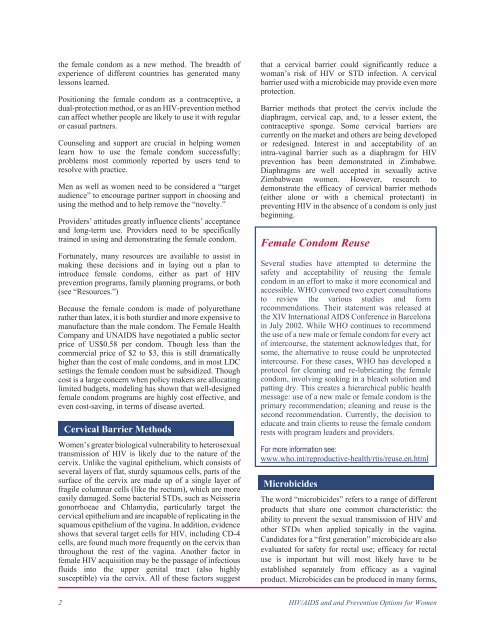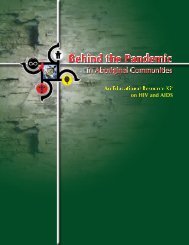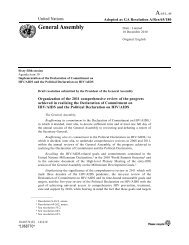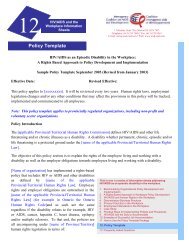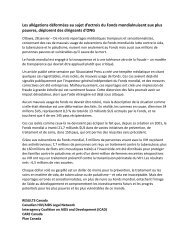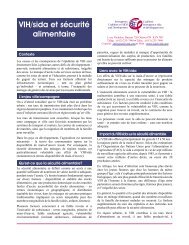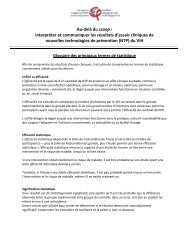HIV/AIDS and Prevention Options for Women - Interagency Coalition ...
HIV/AIDS and Prevention Options for Women - Interagency Coalition ...
HIV/AIDS and Prevention Options for Women - Interagency Coalition ...
Create successful ePaper yourself
Turn your PDF publications into a flip-book with our unique Google optimized e-Paper software.
the female condom as a new method. The breadth of<br />
experience of different countries has generated many<br />
lessons learned.<br />
Positioning the female condom as a contraceptive, a<br />
dual-protection method, or as an <strong>HIV</strong>-prevention method<br />
can affect whether people are likely to use it with regular<br />
or casual partners.<br />
Counseling <strong>and</strong> support are crucial in helping women<br />
learn how to use the female condom successfully;<br />
problems most commonly reported by users tend to<br />
resolve with practice.<br />
Men as well as women need to be considered a “target<br />
audience” to encourage partner support in choosing <strong>and</strong><br />
using the method <strong>and</strong> to help remove the “novelty.”<br />
Providers’ attitudes greatly influence clients’ acceptance<br />
<strong>and</strong> long-term use. Providers need to be specifically<br />
trained in using <strong>and</strong> demonstrating the female condom.<br />
Fortunately, many resources are available to assist in<br />
making these decisions <strong>and</strong> in laying out a plan to<br />
introduce female condoms, either as part of <strong>HIV</strong><br />
prevention programs, family planning programs, or both<br />
(see “Resources.”)<br />
Because the female condom is made of polyurethane<br />
rather than latex, it is both sturdier <strong>and</strong> more expensive to<br />
manufacture than the male condom. The Female Health<br />
Company <strong>and</strong> UN<strong>AIDS</strong> have negotiated a public sector<br />
price of US$0.58 per condom. Though less than the<br />
commercial price of $2 to $3, this is still dramatically<br />
higher than the cost of male condoms, <strong>and</strong> in most LDC<br />
settings the female condom must be subsidized. Though<br />
cost is a large concern when policy makers are allocating<br />
limited budgets, modeling has shown that well-designed<br />
female condom programs are highly cost effective, <strong>and</strong><br />
even cost-saving, in terms of disease averted.<br />
Cervical Barrier Methods<br />
<strong>Women</strong>’s greater biological vulnerability to heterosexual<br />
transmission of <strong>HIV</strong> is likely due to the nature of the<br />
cervix. Unlike the vaginal epithelium, which consists of<br />
several layers of flat, sturdy squamous cells, parts of the<br />
surface of the cervix are made up of a single layer of<br />
fragile columnar cells (like the rectum), which are more<br />
easily damaged. Some bacterial STDs, such as Neisseria<br />
gonorrhoeae <strong>and</strong> Chlamydia, particularly target the<br />
cervical epithelium <strong>and</strong> are incapable of replicating in the<br />
squamous epithelium of the vagina. In addition, evidence<br />
shows that several target cells <strong>for</strong> <strong>HIV</strong>, including CD-4<br />
cells, are found much more frequently on the cervix than<br />
throughout the rest of the vagina. Another factor in<br />
female <strong>HIV</strong> acquisition may be the passage of infectious<br />
fluids into the upper genital tract (also highly<br />
susceptible) via the cervix. All of these factors suggest<br />
that a cervical barrier could significantly reduce a<br />
woman’s risk of <strong>HIV</strong> or STD infection. A cervical<br />
barrier used with a microbicide may provide even more<br />
protection.<br />
Barrier methods that protect the cervix include the<br />
diaphragm, cervical cap, <strong>and</strong>, to a lesser extent, the<br />
contraceptive sponge. Some cervical barriers are<br />
currently on the market <strong>and</strong> others are being developed<br />
or redesigned. Interest in <strong>and</strong> acceptability of an<br />
intra-vaginal barrier such as a diaphragm <strong>for</strong> <strong>HIV</strong><br />
prevention has been demonstrated in Zimbabwe.<br />
Diaphragms are well accepted in sexually active<br />
Zimbabwean women. However, research to<br />
demonstrate the efficacy of cervical barrier methods<br />
(either alone or with a chemical protectant) in<br />
preventing <strong>HIV</strong> in the absence of a condom is only just<br />
beginning.<br />
Female Condom Reuse<br />
Several studies have attempted to determine the<br />
safety <strong>and</strong> acceptability of reusing the female<br />
condom in an ef<strong>for</strong>t to make it more economical <strong>and</strong><br />
accessible. WHO convened two expert consultations<br />
to review the various studies <strong>and</strong> <strong>for</strong>m<br />
recommendations. Their statement was released at<br />
the XIV International <strong>AIDS</strong> Conference in Barcelona<br />
in July 2002. While WHO continues to recommend<br />
the use of a new male or female condom <strong>for</strong> every act<br />
of intercourse, the statement acknowledges that, <strong>for</strong><br />
some, the alternative to reuse could be unprotected<br />
intercourse. For these cases, WHO has developed a<br />
protocol <strong>for</strong> cleaning <strong>and</strong> re-lubricating the female<br />
condom, involving soaking in a bleach solution <strong>and</strong><br />
patting dry. This creates a hierarchical public health<br />
message: use of a new male or female condom is the<br />
primary recommendation; cleaning <strong>and</strong> reuse is the<br />
second recommendation. Currently, the decision to<br />
educate <strong>and</strong> train clients to reuse the female condom<br />
rests with program leaders <strong>and</strong> providers.<br />
For more in<strong>for</strong>mation see:<br />
www.who.int/reproductive-health/rtis/reuse.en.html<br />
Microbicides<br />
The word “microbicides” refers to a range of different<br />
products that share one common characteristic: the<br />
ability to prevent the sexual transmission of <strong>HIV</strong> <strong>and</strong><br />
other STDs when applied topically in the vagina.<br />
C<strong>and</strong>idates <strong>for</strong> a “first generation” microbicide are also<br />
evaluated <strong>for</strong> safety <strong>for</strong> rectal use; efficacy <strong>for</strong> rectal<br />
use is important but will most likely have to be<br />
established separately from efficacy as a vaginal<br />
product. Microbicides can be produced in many <strong>for</strong>ms,<br />
2 <strong>HIV</strong>/<strong>AIDS</strong> <strong>and</strong> <strong>and</strong> <strong>Prevention</strong> <strong>Options</strong> <strong>for</strong> <strong>Women</strong>


